The Origins of the 18 Shakti Peethas
In Hindu mythology, the 18 Shakti Peethas are among the most important and powerful temples dedicated to the Goddess. They came into being after a tragic event involving Goddess Sati, the first wife of Lord Shiva. When her father Daksha insulted Shiva during a sacred ceremony, Sati was deeply hurt and burned herself in sorrow. Then, Shiva, filled with grief and anger, carried her body and performed the fierce Tandava, the dance of destruction. To save the universe, Lord Vishnu used his Sudarshan Chakra to cut Sati’s body into pieces. These pieces fell in different places on Earth, and each place became a Shakti Peethas, where the power of the 18 Goddess is believed to still live.
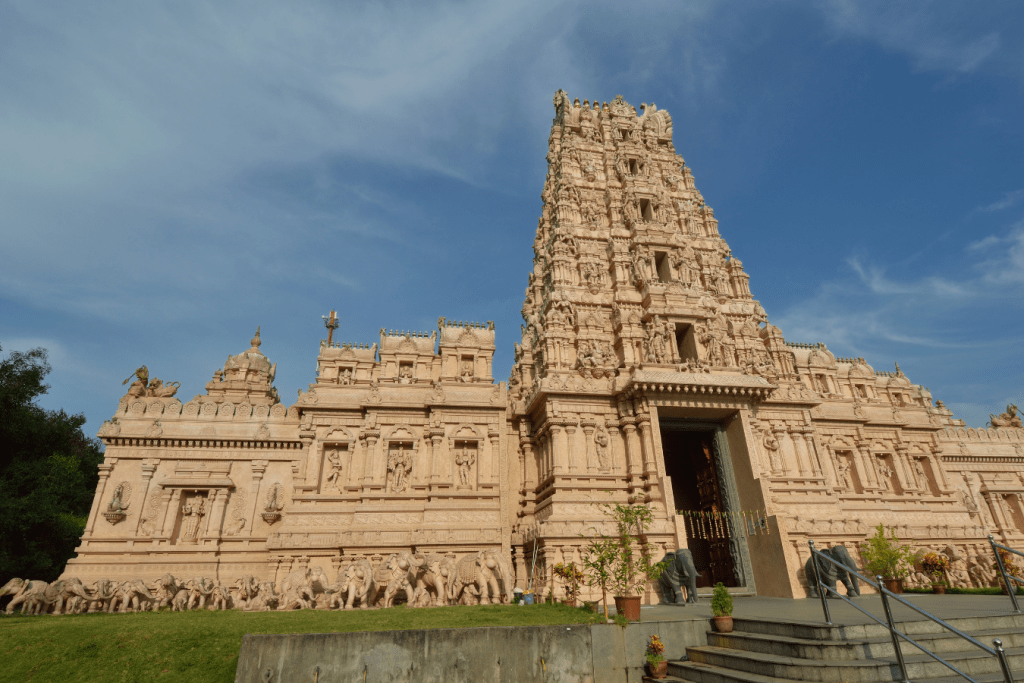
There are traditionally 51 or 52 Shakti Peethas located across India, Nepal, Bangladesh, Sri Lanka, and even in Pakistan and Tibet. Each one corresponds to a specific part of Sati’s body or her ornaments, and is guarded by a fierce aspect of Shiva known as Bhairava. These sites are both spiritually significant and historically revered, drawing countless pilgrims every year.
Among them, a sacred group of eighteen temples holds special importance. These are the Astadasha Shakti Peethas, meaning “18 Seats of the Goddess,” which were identified and glorified by the great saint and philosopher Adi Shankaracharya. These temples are not only active centers of worship but also embody the living energy of the divine feminine.
So, whether you are a pilgrim seeking blessings, a seeker in search of inner peace, or a traveler exploring India’s sacred geography, these 18 Shakti Peethas offer a journey into the heart of India’s spiritual legacy. They are, in every sense, places where the goddess still breathes through faith, tradition, and the land itself.
The 18 Astadasha Shakti Peethas – Detailed Overview
Each of the following temples is a vibrant center of Shakti worship, with its own story, architectural beauty, and spiritual significance.
1. Kamakhya Devi – Guwahati, Assam
Kamakhya Temple is one of the most powerful and sacred of 18 Shakti Peethas in India. It is located on the Nilachal Hills in Guwahati, Assam, surrounded by nature and overlooking the mighty Brahmaputra River. According to legend, this is the place where the yoni (womb) of Goddess Sati fell, after her body was cut by Lord Vishnu to calm Lord Shiva’s grief. Because of this, the temple is a symbol of feminine energy, creation, and power.
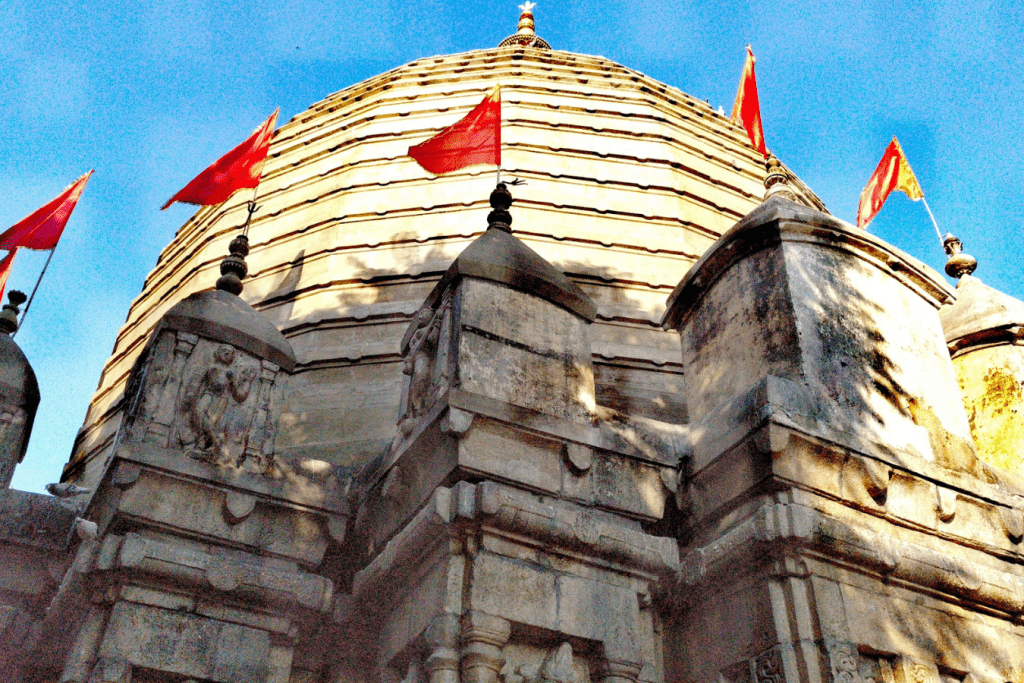
Inside the temple, there is no statue of the goddess. Instead, there is a natural rock crevice that is shaped like a yoni and always has water flowing from it. This is worshipped as the living presence of the goddess. Kamakhya is known for its strong spiritual power, especially in Tantric worship.
Specialty:
- One of the oldest temples of India, linked to ancient Tantra.
- There are 10 other small temples nearby, so each for a different powerful form of Goddess Shakti.
- It’s a major center for Tantric practices and spiritual seekers.
Best Time to Visit:
- The most famous time to visit is during the Ambubachi Mela in June. It is believed that the goddess has her annual menstrual cycle during this time. The temple closes for 3 days and reopens on the 4th with big celebrations.
- Navratri and Durga Puja are also very popular times to visit.
Why Visit:
- To feel the raw spiritual power of the divine feminine.
- The natural rock cave and water spring make it a very unique and holy place.
- The view of the city and river from the hill is beautiful.
- It is a place where myth, nature, and devotion come together.
2. Shringeri Sharadamba – Karnataka
Shringeri is a calm and spiritual town located in the Western Ghats of Karnataka, known for its peaceful surroundings and deep spiritual energy. The main temple here is dedicated to Goddess Sharadamba, a form of Saraswati, the goddess of wisdom, learning, and knowledge.
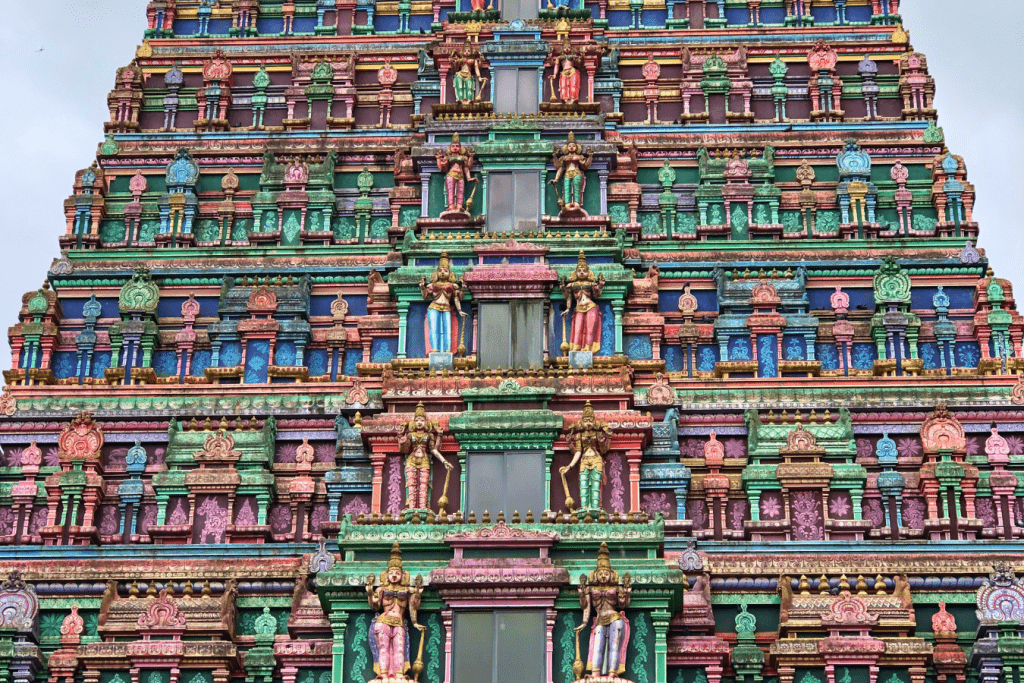
The temple was established by the great saint Adi Shankaracharya over 1,200 years ago. According to legend, he chose this spot after seeing a cobra spreading its hood to protect a pregnant frog from the hot sun—a sign of harmony and divine presence. He built this temple and also set up a major center of Vedic education, which still exists today.
Specialty:
- Founded by Adi Shankaracharya himself, making it one of the most respected religious sites in India.
- The town is home to one of the four major mathas (monastic centers) started by Shankaracharya.
- Sharadamba is worshipped as the goddess who blesses devotees with intelligence, memory, and creativity.
Best Time to Visit:
- The best time to visit is during Navratri in October, when the temple celebrates the goddess with special rituals, lights, and music.
- The weather is also pleasant during this time, making your visit peaceful and comfortable.
Why Visit:
- Enjoy the calm and spiritual feeling along the banks of the Tunga River.
- Witness Vedic chants and rituals performed by students of the matha.
- Feel the peaceful silence and cool breeze of the Western Ghats.
- A perfect place for anyone who seeks knowledge, peace, and inner growth.
3. Chamundeshwari – Mysuru, Karnataka
Chamundeshwari Temple sits atop Chamundi Hill, offering panoramic views of Mysuru city. The goddess here is a fierce form of Durga who is believed to have slain the buffalo demon Mahishasura, also symbolizing the victory of good over evil.
The temple is grand yet peaceful, and it holds great cultural importance, especially during Dussehra when the city celebrates the goddess’s triumph with grandeur.
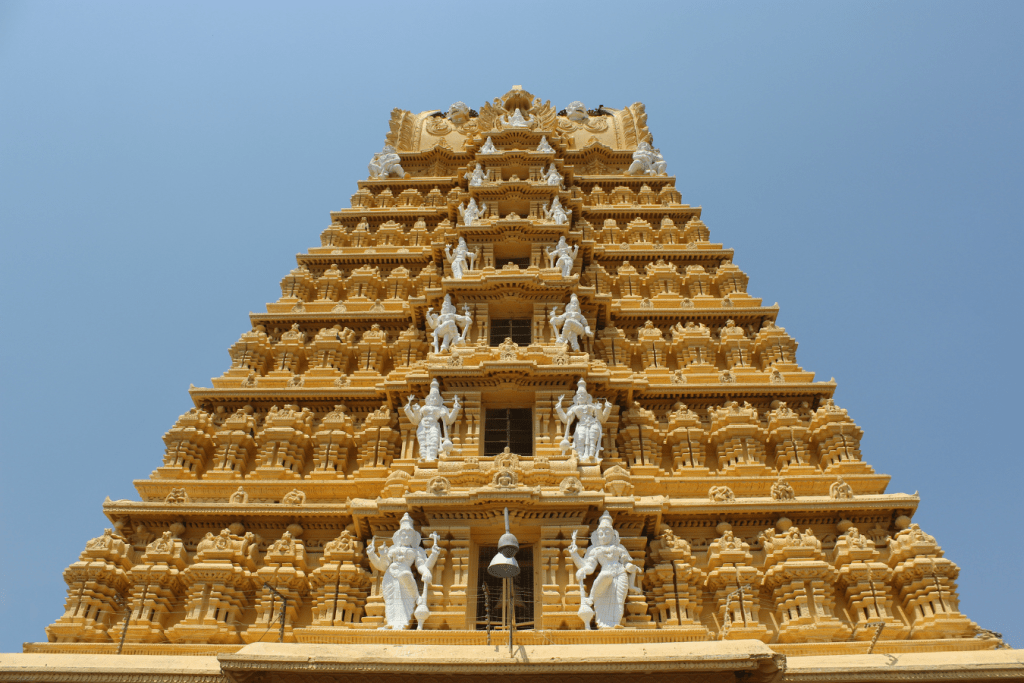
Specialty:
- Iconic location with views of Mysuru Palace and city.
- 1,000+ steps lead to the top—great for devotees and trekkers alike.
- The idol of Chamundeshwari is adorned with gold and precious jewels.
Best Time to Visit:
- Dussehra (September–October) when the temple is beautifully decorated and festivities are in full swing.
Why Visit:
- Blend of nature, devotion, and local heritage.
- Rich history and sacred ambience above the clouds.
4. Mahalakshmi – Kolhapur, Maharashtra
Located in Kolhapur, this temple is dedicated to Mahalakshmi, the goddess of wealth and strength, also known as Ambabai. It is believed that Sati’s eyes fell here.
The temple is a masterpiece of Hemadpanthi architecture, and the deity is worshipped with deep devotion by locals and visitors alike.
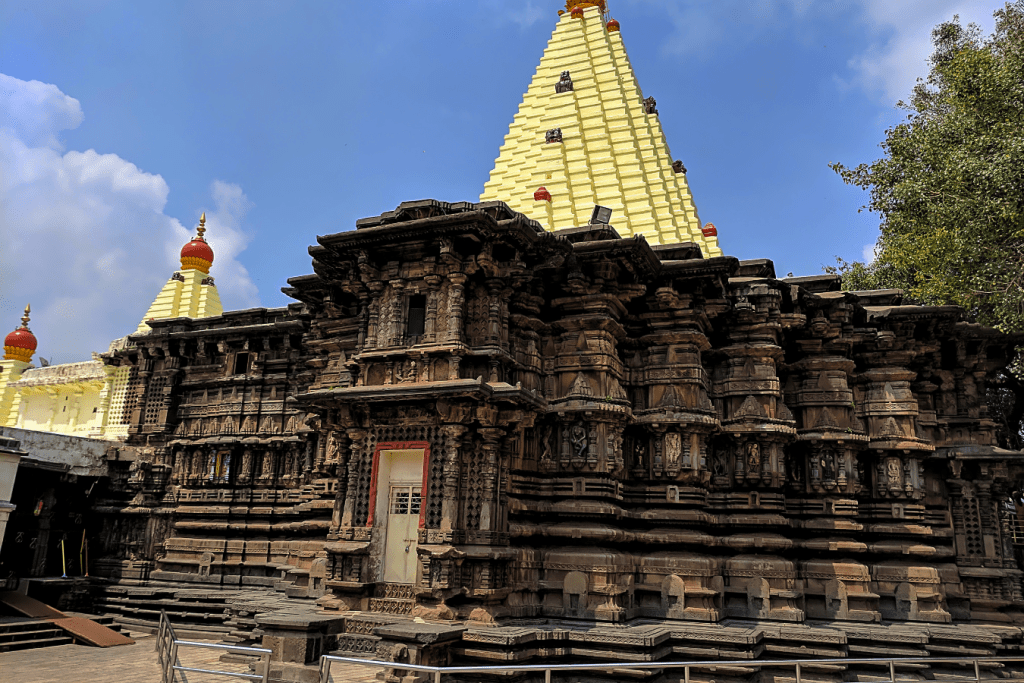
Specialty:
- Unique black stone idol with four arms holding lotus, mace, shield, and fruit.
- The goddess is said to have fought and defeated demons right here.
Best Time to Visit:
- Navratri and Diwali, when the temple glows with lights and devotion.
Why Visit:
- Strong spiritual vibrations.
- Rich Maratha history and temple carvings.
- Believed to grant prosperity and protection.
5. Renuka Devi – Mahur, Maharashtra
Nestled in the Satpura hills, Renuka Devi Temple is dedicated to the mother of Parashurama, also one of Lord Vishnu’s incarnations. This serene temple is surrounded by forests and legends.
Renuka represents so aspect of motherhood and nurturing energy.
Specialty:
- Birthplace of Lord Parashurama.
- Revered for maternal blessings and protection.
Best Time to Visit:
- Dussehra, when special events and processions take place.
Why Visit:
- Peaceful natural setting and deep mythology.
- Ancient heritage and pure energy.
6. Tulja Bhavani – Tuljapur, Maharashtra
Tulja Bhavani is one of the fiercest and most protective forms of Shakti. The temple was especially revered by Chhatrapati Shivaji Maharaj, who considered Bhavani his guardian goddess.
She is believed to bestow strength, courage, and also protection to her devotees.
Specialty:
- Historic importance in the Maratha empire.
- The goddess is worshipped in the form of a fierce warrior queen.
Best Time to Visit:
- Navratri, when the temple becomes a major center of worship.
Why Visit:
- Feel the power and courage invoked by Bhavani Devi.
- A must-visit for those drawn to warrior energy and history.
7. Saptashrungi – Vani, Maharashtra
Located on a mountain with seven peaks, Saptashrungi means “goddess of the seven hills.” The temple is carved into the rock and features a grand idol with 18 hands, each holding a different weapon.
It’s a popular pilgrimage site and also offers a trekking trail with scenic views.
Specialty:
- 108 names of the goddess inscribed in the temple.
- Idol is naturally carved into the hill’s rock face.
Best Time to Visit:
- Chaitra Navratri (March–April).
Why Visit:
- Breathtaking mountain views and spiritual adventure.
- Blend of nature, power, and devotion.
8. Vaishno Devi – Jammu & Kashmir
One of the most visited Shakti shrines in India, Vaishno Devi sits high in the Trikuta Hills. Devotees trek 12 km to reach the holy cave also where the goddess manifests as Mahakali, Mahalakshmi, and Mahasaraswati.
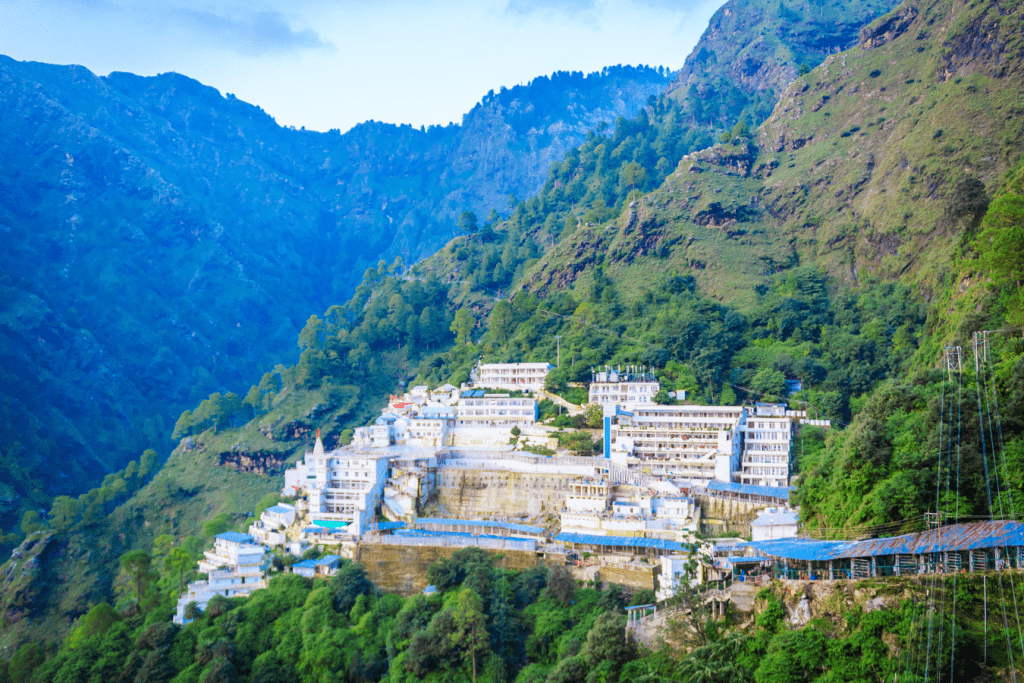
The journey itself is considered sacred and spiritually uplifting.
Specialty:
- No idol—natural rock formations (Pindis) represent the goddess.
- Night treks lit by chanting pilgrims.
Best Time to Visit:
- Navratri, when the spiritual energy is at its peak.
Why Visit:
- Sacred journey through the mountains.
- Powerful devotion, unity, and divine energy in the cave.
9. Vindhyavasini – Vindhyachal, Uttar Pradesh
Situated on the banks of the Ganga River, Vindhyavasini Temple marks the place where the goddess chose to live after defeating Mahishasura. She is also believed to fulfill wishes quickly and lovingly.
It is a major Shakti Peetha for northern India.
Specialty:
- Spiritual center since Vedic times.
- Believed to fulfill wishes without delay.
Best Time to Visit:
- Navratri and Chaitra Navratri.
Why Visit:
- Easy access and powerful blessings.
- Surrounded by scenic ghats and vibrant spiritual energy.
10. Vishalakshi – Varanasi, Uttar Pradesh
Vishalakshi Temple, nestled near the sacred Kashi Vishwanath Temple in Varanasi, marks the spot where Sati’s earrings believed to have fallen. Devotees worship Goddess Vishalakshi here alongside Lord Shiva, so this sacred site radiates a powerful blend of masculine and feminine energy.
Whether you’re a pilgrim drawn by devotion or a seeker looking for inner balance, this temple welcomes everyone with its ancient wisdom and divine presence. Also, being in the spiritual heart of Kashi adds an unmatched depth to the experience.
Specialty:
- It stands as one of the oldest Shakti Peethas, rooted in deep mythology.
- Also, its close proximity to the Kashi Vishwanath Temple allows devotees to receive dual blessings in one powerful visit.
Best Time to Visit:
- Year-round, as Varanasi never loses its spiritual rhythm.
- Then, during festivals like Shivratri and Navratri, the temple becomes especially vibrant and alive with devotion.
Why Visit:
- Seek blessings from both Shiva and Shakti at a single sacred location.
- Also, soak in the rich culture of Varanasi, walk along the ghats of the Ganga, and experience the eternal spiritual energy that flows through the city.
- But more than anything, come to reconnect—with the divine, with yourself, and with the timeless rhythm of devotion that never fades in Kashi.
11. Mangala Gauri – Gaya, Bihar
Mangala Gauri Temple stands as one of the most sacred and serene spots in Gaya, a city already rich in spiritual energy. Devotees believe that the breast of Sati fell here, which symbolizes nourishment, compassion, and divine motherhood.
So, pilgrims—especially newlyweds and couples—climb the temple hill to seek blessings for family life, harmony, and fertility. The gentle, nurturing energy of this site creates a sense of warmth and comfort that continues to attract thousands, especially during the holy month of Sawan.
Also, this temple holds unique importance among women devotees, who revere it as a place of maternal strength and divine grace.
Specialty:
- The temple connects deeply with themes of motherly love and fertility.
- It is one of the few Shakti Peethas especially revered by women, so it holds a special place in their hearts.
Best Time to Visit:
- Sawan (July–August), during the monsoon season, when the spiritual energy of the temple feels especially alive and auspicious.
Why Visit:
- Whether you’re starting a new chapter in life or praying for family blessings, this temple offers divine support for well-being and unity.
- Then, as you stand amidst the peaceful surroundings of Gaya, you’ll feel the spiritual calm and holy vibrations that uplift and heal.
- Also, the temple’s loving energy helps strengthen both personal faith and family bonds.
- But it’s not just about rituals—the inner peace you find here can stay with you long after your visit ends.
12. Tara Tarini – Berhampur, Odisha
Located on the banks of the Rushikulya River, Tara Tarini Temple a twin-deity shrine dedicated to goddesses Tara and Tarini. According to legend, the breasts of Sati fell here, symbolizing nourishment and creation.
Perched on a hilltop, it offers panoramic views, and is a must-visit during the Chaitra Mela which attracts lakhs of devotees.
Specialty:
- Goddess of navigation and protection for sailors and fishermen.
- Large-scale rituals during Chaitra.
Best Time to Visit:
- March–April during the Chaitra festival.
Why Visit:
- Tranquil hill views, river below, and strong protective energy.
- Deeply connected to Odisha’s maritime traditions.
13. Biraja Devi – Jajpur, Odisha
At this sacred site in Odisha, devotees believe that the navel (nabhi) of Sati fell, turning it into a powerful energy center for purification and spiritual awakening. The goddess here—Biraja, a distinct form of Durga—holds a unique presence. She appears with two hands and uses her trident to pierce the chest of Mahishasura, symbolizing the victory of clarity over ego.
So, whether you’re dealing with inner struggles or seeking karmic cleansing, the calm and ancient atmosphere of this temple guides you toward clarity and renewal. Also, the energy here supports deep meditation, free from the distractions of modern commercialism.
Specialty:
- Believers say the temple removes powerful doshas like Pitru Dosha and Rahu-Ketu Dosha.
- A peaceful and less commercialized space for focused devotion and introspection.
Best Time to Visit:
- Durga Puja (September–October), when the spiritual vibrations reach their peak and celebrations draw in seekers from across the region.
Why Visit:
- The quiet energy of the temple allows for deep meditation and karmic healing.
- Then, as you reflect within its sacred space, you may feel lighter, clearer, and more connected.
- Also, the temple holds both historical and mythological importance in Odisha’s spiritual legacy.
- But unlike crowded centers, Biraja offers stillness, ideal for sincere seekers looking for transformation.
14. Jwalaji – Kangra, Himachal Pradesh
One of the most mysterious Shakti Peethas, Jwalaji Temple is unique because it has no idol—instead, natural eternal flames burst from the rock in the sanctum. These flames believed to be the manifestation of Sati’s tongue.
Legends say that even Mughal emperor Akbar tried to extinguish the flames but failed.
Specialty:
- Eternal flames in different sanctums named after different goddesses.
- Pure elemental worship—flame instead of form.
Best Time to Visit:
- Navratri, especially in April and October.
Why Visit:
- Truly awe-inspiring natural phenomenon.
- Himalayan backdrop, spiritual mystery, and divine fire.
15. Ambaji – Banaskantha, Gujarat
Situated in the serene Aravalli hills, Ambaji Temple stands as one of the oldest and most revered Shakti Peethas. Here, devotees believe that the heart of Sati fell, giving the place its powerful spiritual aura. Unlike many temples, So the goddess not represented by an idol; instead, worshippers offer prayers to a sacred Yantra, charged with intense spiritual energy.
So, whether you’re a dedicated pilgrim or a spiritual seeker, Ambaji offers a profound experience. Pilgrims often walk the 51-mile yatra route barefoot, showing immense devotion and faith. Also, the journey through rugged hills and dry desert terrain tests and transforms the devotee.
Specialty:
- No idol—only a powerful and ancient Sri Yantra etched into the temple.
- One of the most vibrant and active pilgrimage destinations in western India.
Best Time to Visit:
- Bhadrapad Purnima Fair (August–September), when the temple comes alive with celebration and deep devotion.
Why Visit:
- The pilgrimage route takes you through both desert landscapes and rolling hills.
- Then, when you reach the temple, the strong vibrations of the Yantra and the temple’s unique rituals offer an unforgettable spiritual experience.
- But more than anything, Ambaji invites you to feel the living presence of Shakti—powerful, raw, and endlessly compassionate.
16. Hinglaj Mata – Hingol, Balochistan, Pakistan
This sacred site stands as one of the few Shakti Peethas located outside India, where Sati’s Brahmarandhra (crown of the head) fell, according to legend. You’ll find it deep within a remote desert cave in Pakistan, a place that holds deep spiritual significance for Sindhi Hindus.
Also, despite political borders and logistical challenges, thousands of devotees travel here during the Hinglaj Yatra, demonstrating unwavering faith and unity. Whether you’re a seeker of ancient traditions or someone drawn to raw spiritual power, Hinglaj Mata welcomes both with open arms.
Specialty:
- Only Shakti Peetha located in Pakistan.
- Sacred natural cave that radiates profound spiritual silence.
Best Time to Visit:
- April, during the powerful and sacred Hinglaj Yatra.
Why Visit:
- So many pilgrims walk this ancient route, crossing desert and river—it’s a spiritual journey, not just a destination.
- The site symbolizes both survival and deep-rooted devotion that transcends borders.
- Then again, if you’re looking to connect with the goddess in one of her rawest and most primal settings, this is the place.
17. Kanchi Kamakshi – Kanchipuram, Tamil Nadu
Kamakshi is a peaceful and meditative form of Shakti seated in Padmasana (lotus posture). She is the only Shakti among the famous Trinity of Devi Temples in South India, alongside Meenakshi and Visalakshi.
The temple is grand, filled with detailed sculptures, and is a seat of Shakta philosophy.
Specialty:
- Major spiritual and educational center for Advaita Vedanta.
- The goddess holds sugarcane, lotus, and parrot, symbolizing love and wisdom.
Best Time to Visit:
- Brahmotsavam (February).
Why Visit:
- Tranquil spiritual experience in a temple city.
- Connection with Shankaracharya and Vedic learning.
18. Meenakshi – Madurai, Tamil Nadu
One of the grandest temples in India, Meenakshi Temple is the heart of Madurai. The goddess Meenakshi, with fish-shaped eyes, is the ruling deity of this city, alongside her consort Lord Sundareswarar (Shiva).
The temple complex is a marvel of Dravidian architecture, filled with colorful towers, musical pillars, and a sacred pond.
Specialty:
- Massive temple complex with 14 gopurams.
- Celebrates the divine marriage of Shiva and Shakti.
Best Time to Visit:
- April, during Meenakshi Tirukalyanam (divine wedding).
Why Visit:
- Architectural grandeur, vibrant culture, and living spirituality.
- Experience divine love and artistic brilliance.
Conclusion
The Astadasha 18 Shakti Peethas don’t just stand as temples—they embody divine energy, devotion, and centuries of living history that continue to inspire millions across generations. Whether you feel drawn to the fierce warrior spirit of Bhavani in Tuljapur, the meditative serenity of Kamakshi in Kanchipuram, or the raw elemental force of Jwalaji’s eternal flames, each site opens a unique doorway to the Goddess’s grace.
So, what sets these 18 Shakti Peethas apart isn’t only their mythological roots—it’s the vibrant, ongoing devotion that thrives in every ritual, chant, and offering. Both spiritual seekers and casual pilgrims walk away transformed, touched by the sacred atmosphere, timeless traditions, and the breathtaking natural and architectural beauty that surrounds these shrines.
Also, these temples remind us of the immense strength of the divine feminine—Shakti—in all her dynamic forms: nurturing, protective, wise, and transformative. These sacred sites stand as spiritual beacons across the varied landscapes of India and beyond, yet they all connect through a shared thread of reverence, mythology, and a living cultural legacy.